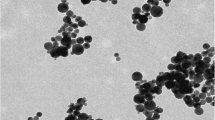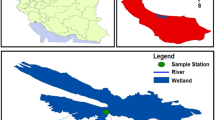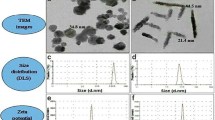Abstract
In this study adsorption of arsenic (As) onto TiO2 nanoparticles and the facilitated transport of As into carp (Cyprinus carpio) by TiO2 nanoparticles was examined. Adsorption kinetics and adsorption isotherm were conducted by adding As(V) to TiO2 suspensions. Facilitated transport of As by TiO2 nanoparticles was assessed by accumulation tests exposing carp to As(V) contaminated water in the presence of TiO2 nanoparticles. The results showed that TiO2 nanoparticles had a significant adsorption capacity for As(V). Equilibrium was established within 30 min and the isotherm data was described by Freundlich isotherm. The KF and 1/n were 20.71 mg/g and 0.58, respectively. When exposed to As(V)-contaminated water in the presence of TiO2 nanoparticles, carp accumulated considerably more As, and As concentration in carp increased by 132% after 25 days exposure. Considerable As and TiO2 accumulated in intestine, stomach and gills of the fish, and the lowest level of accumulation was found in muscle. Accumulation of As and TiO2 in stomach, intestine and gills are significant. Arsenic accumulation in these tissues was enhanced by the presence of TiO2 nanoparticles. TiO2 nanoparticles that have accumulated in intestine and gills may release adsorbed As and As bound on TiO2 nanoparticles which cannot be released maybe transported by TiO2 nanoparticles as they transferred in the body. In this work, an enhancement of 80% and 126% As concentration in liver and muscle after 20 days of exposure was found.
Similar content being viewed by others
References
Amrhein, C., Mosher, P. A., & Strong, J. E. (1993). Colloid-assisted transport of trace metals in roadside soils receiving deicing salts. Soil Science Society of American Journal, 57, 1212–1217.
Afaq, F., Abidi, P., Matin, R., & Rahman, Q. (1998). Cytotoxicity, pro-oxidant effects and antioxidant depletion in rat lung alveolar macrophages exposed to ultrafine titanium dioxide. Journal of Applied Toxicology, 18, 307–312.
Davis, A., Sellstone, C., Clough, S., Barrick, R., & Yare, B. (1996). Bioaccumulation of arsenic chromium and lead in fish: Constraints imposed by sediment geochemistry. Applied Geochemistry, 11, 409–423.
Donaldson, K., Stone, V., Gilmour, P. S., Brown, D. M., & MacNee, W. (2000). Ultrafine particles: Mechanisms of lung injury. Philosophical Transactions of the Royal Society of London B, 358, 2741–2749.
Dutta, K. P., Ray, K. A., Sharma, K. V., & Millero, J. F. (2004). Adsorption of arsenate and arsenite on titanium dioxide suspensions. Journal of Colloid and Interface Science, 278, 270–275.
ETC Group (2003). No small matter II: The case for a global moratorium. Occasional Paper Series,7(1).
Flury, M., Mathison, J. B., & Harsh, J. B. (2002). In situ mobilization of colloids and transport of cesium in Hanford sediments. Environmental Science & Technology, 36, 5335–5341.
Grolimund, D., Borkovec, M., Barmettler, K., & Sticher, H. (1996). Colloid-facilitated transport of strongly sorbing contaminants in natural porous media: A laboratory column study. Environmental Science & Technology, 30, 3118–3123.
Gumbleton, M. (2001). Caveolae as potential macromolecule trafficking compartments within alveolar epithelium. Advanced Drug Delivery Reviews, 49, 281–300.
Handy, R. D., & Eddy, F. B. (1991). Effects of inorganic cations on Na+ adsorption to the gill and body surface of rainbow trout Oncorhynchus mykiss (Walbaum) in dilute solutions. Canadian Journal of Fisheries and Aquatic Sciences, 48, 1829–1837.
Honeyman, B. D. (1999). Colloid culprits in contamination. Nature, 397, 23–24.
Howard, C. V., & Maynard, R. L. (1999). Particulate matter: Properties and effects upon health. Oxford, New York: BIOS Scientific.
Kipp, J. E. (2004). The role of solid nanoparticle technology in the parenteral delivery of poorly water-soluble drugs. International Journal of Pharmaceutics, 284, 109–122.
Kong, J., Franklin, R. N., Zhou, C. W., Chapline, G. M., Peng, S., Cho, K. et al. (2000). Nanotube molecular wires as chemical sensors. Science, 287, 622–625.
Králik, M., & Biffis, A. (2001). Catalysis by metal nanoparticles supported on functional organic polymers. Journal of Molecular Catalysis. A. Chemical,177, 113–138.
Kundu, S., Kavalakatt, S. S., Pal, A., Ghosh, K. S., Mandal, M., & Pal, T. (2004). Removal of arsenic using hardened paste of Portland cement: Batch adsorption and column study. Water Research, 38, 3780–3790.
Lewis, A. M., Scott, I. G., Bearden, W. D., Quarles, L. R., Moore, J., Strozier, D. E. et al. (2002). Fish tissue quality in near-coastal areas of the Gulf of Mexico receiving point source discharges. Science of the Total Environment, 284, 249–261.
Long, Q. R., & Yang, R. T. (2001). Carbon nanotubes as superior sorbent for dioxin removal. Journal of the American Chemical Society,123, 2058–2059.
Maia, C. S., Mehnert, W., & Schafer-Korting, M. (2000). Solid lipid nanoparticles as drug carriers for topical glucocorticoids. International Journal of Pharmaceutics, 196, 165–167.
Öberdörster, G. (2000). Toxicology of ultrafine particles: in vivo studies. Philosophical Transactions of the Royal Society of London B, 358, 2719–2740.
Pedlar, R. M., & Klaverkamp J. F. (2002). Accumulation and distribution of dietary arsenic in lake whitefish (Coregonus clupeaformis). Aquatic Toxicology, 57, 153–166.
Pena, M., Meng, X., Korfiatis, G. P., & Jing, C. (2006). Adsorption mechanism of arsenic on nanocrystalline titanium dioxide. Environmental Science & Technology, 40, 1257–1262.
Pendleton, W. G., Whitworth, R. M., & Olsen, H. G. (1995). Accumulation and loss of arsenic and boron, alone and in combination, in Mallard ducks. Environmental Toxicology and Chemistry,14, 1357–1364.
Rahman, Q., Lohani, M., Dopp, E., Pemsel, H., Jonas, L., Weiss, D. G. et al. (2002). Evidence that ultrafine titanium dioxide induces micronuclei and apoptosis in Syrian hamster embryo fibroblasts. Environmental Health Perspectives, 110, 797–800.
Reid, S. D., & McDonald, D. G. (1991). Metal binding activity of the gills of rainbow trout (Oncorhynchus mykiss). Canadian Journal of Fisheries and Aquatic Sciences, 48, 1061–1068.
Roco, M. C., & Bainbridge, W. S. (2001). Societal implications of nanoscience and nanotechnology. Boston: Kluwer
Singh, S. T., & Pant, K. K. (2004). Equilibrium, kinetics and thermodynamic studies for adsorption of As(III) on activated alumina. Separation and Purification Technology, 36, 139–147.
Tan, M. H., Commens C. A., Burnett, L., & Snitch, P. J. (1996). A pilot study on the percutaneous absorption of microfine titanium dioxide from sunscreens. Australian Journal of Dermatology, 37, 185–187.
Tinkle, S. S., Antonini, J. M., & Rich, B. A. (2003). Skin as a route of exposure and sensitization in chronic beryllium disease. Environmental Health Perspectives, 111, 1202–1208.
Zhang, W. X., & Masciangioli, T. (2003). Environmental technologies at the nanoscales. Environmental Science & Technology A-Pages,37, 102A–108A.
Author information
Authors and Affiliations
Corresponding author
Rights and permissions
About this article
Cite this article
Sun, H., Zhang, X., Niu, Q. et al. Enhanced Accumulation of Arsenate in Carp in the Presence of Titanium Dioxide Nanoparticles. Water Air Soil Pollut 178, 245–254 (2007). https://doi.org/10.1007/s11270-006-9194-y
Received:
Accepted:
Published:
Issue Date:
DOI: https://doi.org/10.1007/s11270-006-9194-y




